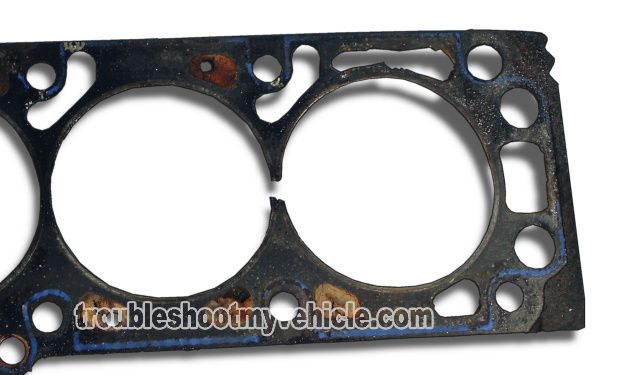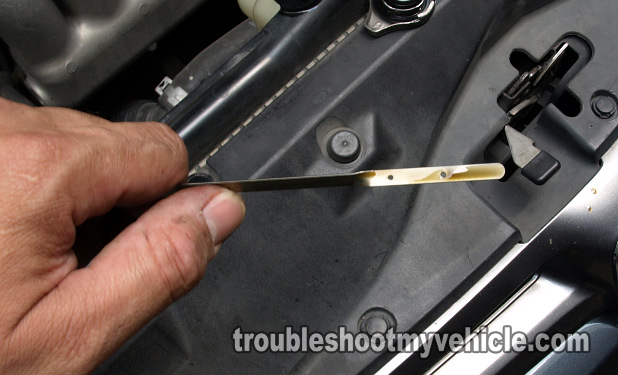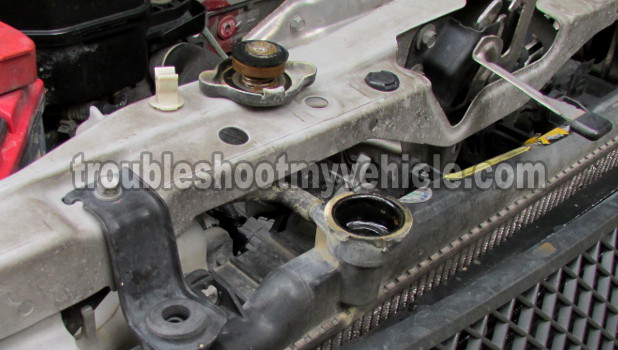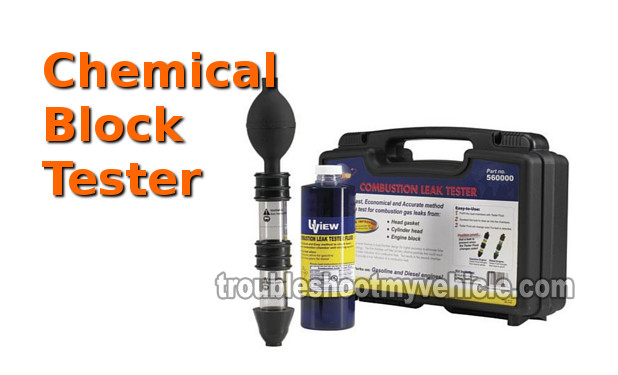
Checking to see if your 1.7L Honda Civic has suffered a blown head gasket can be done in 4 simple tests.
In this tutorial, I'll walk you through all 4 in a step-by-step way so that you can do these tests yourself (if you suspect your 1.7L Honda Civic has a blown head gasket).
Contents of this tutorial:
Symptoms Of A Blown Head Gasket
If your Honda still starts and runs, the most common symptoms of a blown head gasket is that the engine overheats rapidly.
Here are a few other common symptoms a blown head gasket:
- Your Honda Civic is overheating. You've checked that:
- Thermostat is good.
- Both the radiator fan and condenser fan are working.
- Radiator is not busted (leaking coolant).
- Water pump is OK (not leaking coolant).
- Cooling system is full of coolant.
- White smoke is coming out of the tail-pipe and it smells like anti-freeze being cooked.
- Your Honda won't start. You've checked:
- There's spark coming from all 4 ignition coils.
- Fuel is reaching and being injected into the cylinders.
- The engine oil is thick and a tan to an off-white color.
TEST 1: Engine Oil The Color Of 'Coffee With Too Much Creamer'

The most common end result of a blown head gasket is coolant leaking into the crank case where it mixes with the engine oil.
As your Honda Civic's engine is cranked (or as it runs), the oil thoroughly mixes with the coolant and becomes milky white in color.
This can be confirmed by simply pulling out the dipstick and checking the color of the oil and that's what we'll do in this first test.
OK, I'll stop talking and we'll get this show on the road, this is what you need to do:
- 1
Open your Honda's hood and pull out the engine oil dipstick.
What you're looking for is to make sure that the engine oil IS NOT mixed with coolant. If the engine oil is mixed with coolant, it'll be the color of 'coffee with too much creamer'. - 2
What color is the engine oil?
1.) Is it a creamy tan/off-white color.
2.) The engine oil will be its usual normal color.
Alright, let's interpret the color of the engine oil:
CASE 1: The color of the oil is a light tan, like coffee with too much creamer. This result confirms that your Honda's head gasket is blown.
If you're wondering why the oil looks like this? Well this is what happened:
1.) Your Honda overheated to the point that the cylinder head warped (since it's made out of aluminum). This led to the head gasket to burn.
2.) Once the head gasket burns and the head warps, the head gasket is unable to keep engine oil, coolant, and compression/ exhaust gases from mixing.
3.) This leads to the coolant entering the engine oil pan. As both of these mix, the result is an engine oil that is an off-white/tan color.
CASE 2: The color of the engine oil is normal. So far so good, but more testing is necessary to make sure the head gasket is not blown (especially if your Honda is overheating or not starting), go to: TEST 2: Coolant Shooting Out From Open Radiator.
Here's the reason why: In about 90% of the times, a blown head gasket will cause the engine's coolant to mix with the oil, but not always. And so another test or tests are needed to either confirm a blown head gasket or exonerate the head gasket as blown. The next test is to see if the engine's compression/combustion gases are escaping thru' the radiator.
TEST 2: Coolant Shooting Out From Open Radiator

The other very common end result of a blown head gasket is compression/combustion pressures escaping through the cooling system instead of being contained in the cylinder.
This can be very easily verified by checking to see if these pressures are making the coolant shoot out of your Honda Civic's radiator (with cap removed).
If indeed the coolant is being shot out of the radiator while you're cranking your Civic's engine then you've confirmed that the head gasket is blown.
IMPORTANT: If your Honda Civic has been running for an extended amount of time, let the engine cool down for at least an hour! Do not remove the radiator cap from a hot radiator or a hot engine.
There's a good chance that your Honda is not starting, in this case you don't have to worry about a hot engine.
- 1
Remove the radiator's cap. Check to see if there is coolant in the radiator. If the radiator is empty, add some water or coolant to bring it up to the radiator's neck level.
- 2
Crank the engine with the help of helper, while you stand at a safe distance from the open radiator.
- 3
You'll see one of two results:
1.) The water or coolant inside the radiator will shoot up and out of the now open radiator.
2.) The coolant will not be disturbed. In other words, cranking the engine will have no effect on the level of the water or coolant in the radiator.
OK, now that the testing part is done, let's take a look at what your results mean:
CASE 1: The coolant bubbled out or shot out from the radiator. This unfortunate test result tells you, without a shadow of a doubt, that your Honda Civic's head gasket is blown.
This test result only happens when the head gasket has blown and/or the cylinder head has warped due to the engine overheating. No further testing is required.
The normal/correct test result is for the coolant to remain undisturbed (inside the radiator) no matter how long you crank the cold engine.
CASE 2: The coolant DID NOT bubble out NOR shoot out from the radiator. This is the correct and expected test result.
Your next step depends on whether the engine starts and runs:
- If your Honda Civic's engine starts and runs but overheats, go to: TEST 4: Using A Chemical Block Tester (Combustion Leak Tester).
- If your Honda Civic's engine cranks but doesn't start, go to: TEST 3: Engine Compression Test.
TEST 3: Engine Compression Test

If your 1.7L Honda Civic starts and runs, skip this test and go to: TEST 4: Using A Chemical Block Tester (Combustion Leak Tester).
If your Honda Civic overheated and now it doesn't start, the next test is a compression test of all 4 cylinders.
Why a compression test? Because the head gasket has burned at a point between two cylinders, the resulting gap in the head gasket will let the compression/combustion of one cylinder to leak into the other and vice-versa.
The end result of this is that those two cylinder end up with 0 PSI compression and the engine not starting.
This particular problem leads a lot of folks to misdiagnose a blown head gasket on their Honda because it doesn't cause the engine oil wasn't mixed with coolant and the engine coolant wasn't being shot out of the radiator (with cap removed).
This condition can be very easily verified by doing a compression test. In this test step, I'll show you how and more importantly, how to interpret the compression test results to see if the head gasket is burned or not.
NOTE: You can find a more detailed explanation of how to perform and interpret a compression test on your Honda Civic in this tutorial: How To Test The Engine Compression (2001-2005 1.7L Honda Civic).
This is what you'll do:
- 1
Remove all four COP ignition coils.
Remove all four spark plugs too. - 2
Thread in the compression tester by hand, on the first spark plug hole you're gonna' start with.
Do not use any tools to tighten the compression tester. Hand tightening the compression tester is more than enough to get the proper results. - 3
Have a helper crank the engine. Your job is to keep your eyeballs on the compression tester.
- 4
At the point the needle stops climbing, have your helper stop cranking the engine.
- 5
Write down the reading and what cylinder it belongs to (you can use the image above to help you identify the cylinder).
- 6
Repeat the above steps in the remaining 3 cylinders.
Alright, let's find out what it all means:
CASE 1: All cylinder compression readings where normal. These compression gauge readings confirm that the head gasket is OK and not burned at a point between two cylinders.
If you still suspect that your 1.7L Civic has a blown head gasket issue (and if the engine starts and runs), take a look at the next test: TEST 4: Using A Chemical Block Tester (Combustion Leak Tester).
CASE 2: Two side by side cylinders had 0 PSI compression. This engine compression reading confirms that the head gasket is burned thru' at the point between those two cylinders. You'll need to replace the head gasket.
TEST 4: Using A Chemical Block Tester (Combustion Leak Tester)

Using a block tester, to check for a blown head gasket when the previous 3 tests don't confirm it, will tell you without a shadow of doubt if it's blown or not.
Why didn't I start of with this test? Because TEST 1, TEST 2, and TEST 3 usually pinpoint a blown head gasket condition in about 95% of the cases (not to mention you don't have to spend any $ to do them). It's the remaining hard to diagnose 5% percent where the effort of finding a block tester is worth it.
In a nutshell, this is how a block tester works:
- A blue liquid chemical, which is blue in color, is placed in the tester (see photo above).
- The tester assembly is then placed on the open radiator neck (you may have to drain some of the coolant in the radiator since this tool needs to 'gulp' some of the air inside the radiator).
- The rubber bellow is then squeezed to suck in the air up through the two fluid-filled chambers. As the air bubbles up through the fluid, it will cause a chemical reaction.
- If the blue chemical turns yellow (for gasoline engines), combustion gases are entering the radiator. This result confirms a head gasket failure, a cracked block, or a cracked cylinder head issue.
- If the blue chemical doesn't change color, you can conclude that you don't have a head gasket failure, a cracked block, or a cracked cylinder head issue.
Where can you get the chemical and block tester? At your local auto parts store or here:
Disclosure: As an Amazon Associate, I earn from qualifying purchases. If my tutorials help you, using these links is an easy way to support the site at no extra cost to you. Thank you!
More 1.7L Honda Civic Test Tutorials
You can find a complete list of Honda Civic tutorials in this index: 1.7L Honda Civic Index Of Articles.
Here's a small sample of the tutorials you'll find in the index:
- How To Test The Crank Sensor (2001-2005 1.7L Honda Civic).
- Maintenance Required Light Reset (2001-05 1.7L Honda Civic).
- How To Do A Cylinder Balance Test (2001-2005 1.7L Honda).
- How To Test Trouble Code P0141 (2001-2005 Honda 1.7L).
- How To Test The TP Sensor (2001-2005 1.7L Honda Civic).
- How To Test Trouble Code P0135 (2001-2003 Honda 1.7L).

If this info saved the day, buy me a beer!





